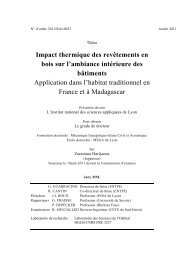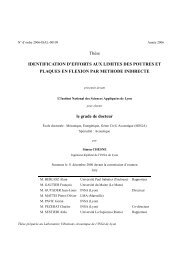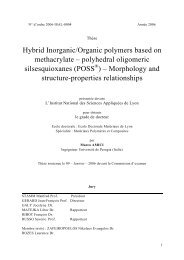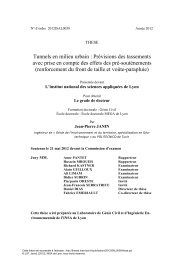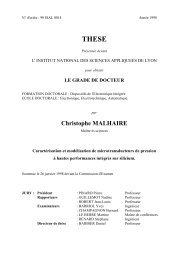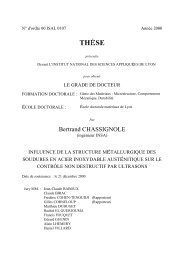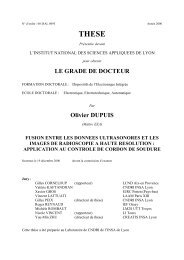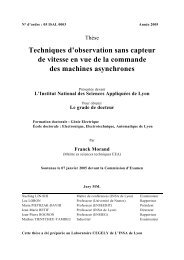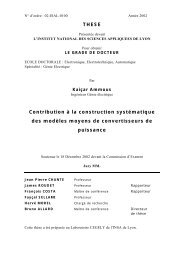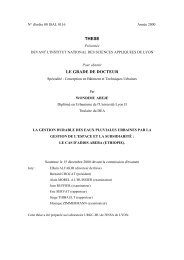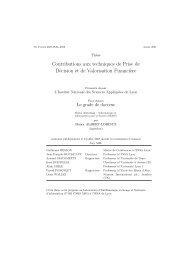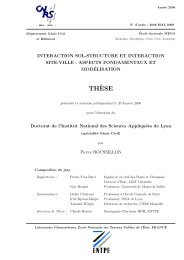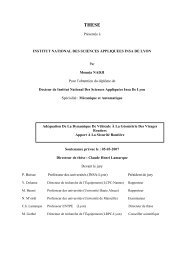- Page 1:
N° d’ordre 2008-ISAL-0115 Année
- Page 5 and 6:
RESUME L'emploi d'additions minéra
- Page 7 and 8:
SOMMAIRE SOMMAIRE SOMMAIRE ........
- Page 9 and 10:
SOMMAIRE 3 Influence du dosage en g
- Page 11 and 12:
LISTE DES FIGURES LISTE DES FIGURES
- Page 13 and 14:
LISTE DES FIGURES Figure 97 : Rési
- Page 15 and 16:
LISTE DES FIGURES Figure 193 : Spec
- Page 17 and 18:
LISTE DES TABLEAUX LISTE DES TABLEA
- Page 19 and 20:
Introduction générale INTRODUCTIO
- Page 21 and 22:
CHAPITRE I ________________________
- Page 23 and 24:
Etude bibliographique 1 Introductio
- Page 25 and 26:
Etude bibliographique Lors de la fa
- Page 27 and 28:
Etude bibliographique La partie vit
- Page 29 and 30:
Etude bibliographique LÉGENDE LAIT
- Page 31 and 32:
Etude bibliographique L’analyse t
- Page 33 and 34:
Etude bibliographique Pour des pH s
- Page 35 and 36:
Etude bibliographique Figure 9 : Di
- Page 37 and 38:
Etude bibliographique à prédire l
- Page 39 and 40:
Etude bibliographique 2.4.1 Activat
- Page 41 and 42:
Etude bibliographique Figure 12 : Q
- Page 43 and 44:
Etude bibliographique Résistance e
- Page 45 and 46:
Etude bibliographique les plus peti
- Page 47 and 48:
Etude bibliographique égal à 1. C
- Page 49 and 50:
Etude bibliographique Retrait de s
- Page 51 and 52:
Etude bibliographique 2.4.1.2 Les f
- Page 53 and 54: Etude bibliographique 2.4.2 Activat
- Page 55 and 56: Etude bibliographique saturée en c
- Page 57 and 58: Etude bibliographique concentration
- Page 59 and 60: Etude bibliographique D’après Ri
- Page 61 and 62: Etude bibliographique Temps [heures
- Page 63 and 64: Etude bibliographique Activation al
- Page 65 and 66: Etude bibliographique Tableau 12 :
- Page 67 and 68: Etude bibliographique fabrication,
- Page 69 and 70: Etude bibliographique Il est possib
- Page 71 and 72: Etude bibliographique 3.2.2 Etapes
- Page 73 and 74: Etude bibliographique est la source
- Page 75 and 76: Etude bibliographique grâce à la
- Page 77 and 78: Etude bibliographique sulfate de ca
- Page 79 and 80: CHAPITRE II _______________________
- Page 81 and 82: Caractérisation des matières prem
- Page 83 and 84: Caractérisation des matières prem
- Page 85 and 86: Caractérisation des matières prem
- Page 87 and 88: Caractérisation des matières prem
- Page 89 and 90: Caractérisation des matières prem
- Page 91 and 92: Caractérisation des matières prem
- Page 93 and 94: Caractérisation des matières prem
- Page 95 and 96: 4 Caractérisation des mortiers dur
- Page 97 and 98: Caractérisation des matières prem
- Page 99 and 100: Caractérisation des matières prem
- Page 101 and 102: Caractérisation des matières prem
- Page 103: Caractérisation des matières prem
- Page 107 and 108: Caractérisation des matières prem
- Page 109 and 110: CHAPITRE III ______________________
- Page 111 and 112: Accélération du CEM III A 1 Intro
- Page 113 and 114: Accélération du CEM III A 2 Optim
- Page 115 and 116: Accélération du CEM III A augment
- Page 117 and 118: Accélération du CEM III A 2.1.2.2
- Page 119 and 120: Accélération du CEM III A 2.1.2.4
- Page 121 and 122: Accélération du CEM III A Gypse Y
- Page 123 and 124: Accélération du CEM III A 2.1.3 C
- Page 125 and 126: Accélération du CEM III A 30 Quan
- Page 127 and 128: Accélération du CEM III A Tableau
- Page 129 and 130: Accélération du CEM III A 90% CEM
- Page 131 and 132: Accélération du CEM III A 2.3 Man
- Page 133 and 134: Accélération du CEM III A 13 6 pH
- Page 135 and 136: Accélération du CEM III A pratiqu
- Page 137 and 138: Accélération du CEM III A 3.1.2 H
- Page 139 and 140: Accélération du CEM III A 60% CEM
- Page 141 and 142: Accélération du CEM III A Plus le
- Page 143 and 144: Accélération du CEM III A Eau non
- Page 145 and 146: Accélération du CEM III A Les dif
- Page 147 and 148: Accélération du CEM III A Figure
- Page 149 and 150: Accélération du CEM III A 2,5 Pr
- Page 151 and 152: Accélération du CEM III A o Les m
- Page 153 and 154: Accélération du CEM III A sans al
- Page 155 and 156:
Accélération du CEM III A 60 60 D
- Page 157 and 158:
Accélération du CEM III A 20 20 G
- Page 159 and 160:
Accélération du CEM III A Sur la
- Page 161 and 162:
Accélération du CEM III A 13,0 12
- Page 163 and 164:
Accélération du CEM III A 60% CEM
- Page 165 and 166:
Accélération du CEM III A 4.2.2 C
- Page 167 and 168:
Accélération du CEM III A 60% CEM
- Page 169 and 170:
Accélération du CEM III A 4.2.3 C
- Page 171 and 172:
Accélération du CEM III A confond
- Page 173 and 174:
Accélération du CEM III A Figure
- Page 175 and 176:
Accélération du CEM III A stratli
- Page 177 and 178:
Accélération du CEM III A 4.2.4 C
- Page 179 and 180:
Accélération du CEM III A 4.2.4.2
- Page 181 and 182:
Accélération du CEM III A 5 Concl
- Page 183 and 184:
CHAPITRE IV _______________________
- Page 185 and 186:
Accélération du CEM L 1 Introduct
- Page 187 and 188:
Accélération du CEM L Figure 122
- Page 189 and 190:
Accélération du CEM L 2.2.3 Calor
- Page 191 and 192:
Accélération du CEM L 2.3.2.1 Etu
- Page 193 and 194:
Accélération du CEM L C-S-H L C-S
- Page 195 and 196:
Accélération du CEM L Tableau 41
- Page 197 and 198:
Accélération du CEM L 3.2 Comport
- Page 199 and 200:
Accélération du CEM L 3.3 Comport
- Page 201 and 202:
Accélération du CEM L Ettringite
- Page 203 and 204:
Accélération du CEM L 20 100% CEM
- Page 205 and 206:
Accélération du CEM L plus import
- Page 207 and 208:
Accélération du CEM L C-S-H L L A
- Page 209 and 210:
Accélération du CEM L 60% CEM L /
- Page 211 and 212:
Accélération du CEM L [ 22 ], d'u
- Page 213 and 214:
Accélération du CEM L 4.3.3.3 Com
- Page 215 and 216:
Accélération du CEM L Yeelimite 1
- Page 217 and 218:
Accélération du CEM L 4.3.4.2 Mé
- Page 219 and 220:
Accélération du CEM L 4.3.4.3 Com
- Page 221 and 222:
Accélération du CEM L -7% -6% -5%
- Page 223 and 224:
Accélération du CEM L 5 Combinais
- Page 225 and 226:
Accélération du CEM L 6 100% CEM
- Page 227 and 228:
Accélération du CEM L Figure 180
- Page 229 and 230:
Accélération du CEM L l'absence d
- Page 231 and 232:
Accélération du CEM L mélange 60
- Page 233 and 234:
Accélération du CEM L Diamètre d
- Page 235 and 236:
Accélération du CEM L 5.2.2.3 Etu
- Page 237 and 238:
Accélération du CEM L n’est alo
- Page 239 and 240:
Accélération du CEM L 5.2.3.3 Var
- Page 241 and 242:
Accélération du CEM L 5.3 Etude d
- Page 243 and 244:
Accélération du CEM L la yeelimit
- Page 245 and 246:
Accélération du CEM L Résistance
- Page 247 and 248:
Accélération du CEM L 90 j Yeelim
- Page 249 and 250:
Accélération du CEM L En comparai
- Page 251 and 252:
Accélération du CEM L 6 Conclusio
- Page 253 and 254:
Conclusion générale CONCLUSION GE
- Page 255 and 256:
Références bibliographiques REFER
- Page 257 and 258:
Références bibliographiques S. D.
- Page 259 and 260:
Références bibliographiques S. N.
- Page 261 and 262:
Références bibliographiques S. Sa
- Page 263 and 264:
Références bibliographiques Norme
- Page 265 and 266:
Références bibliographiques 265
- Page 267 and 268:
Annexes 267
- Page 269 and 270:
Annexe 1 de maintenir sa températu
- Page 271 and 272:
Annexe 1 avec : m c , m s , m e , m
- Page 273 and 274:
Annexe 1 distantes de 1 cm. L’uni
- Page 275 and 276:
Annexe 1 Après avoir traversé l
- Page 277 and 278:
Annexe 2 8 7 CEM I super blanc 100
- Page 279 and 280:
Annexe 2 Hydratation à moyen terme



